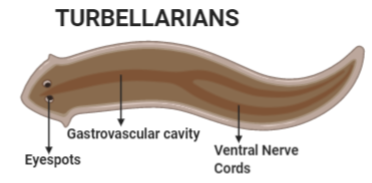
Answer
460.5k+ views
Hint: The Turbellarians are one of the subdivisions of the phylum Platyhelminthes. Platyhelminthes are flat-worms as they are dorso-ventrally flattened and are acoelomate.
Complete answer:

Turbellarians are also known as flatworms. Some characteristics of this class are:
- Bilateral symmetry is present.
- Epidermis is ciliated.
- Nerve fibres are sheathed.
- Dorso-ventral flattening of the organism’s body.
- No segments are present on the body.
- Parenchyma is present in between the epidermis and the gastrodermis.
- Some cephalization is also observed.
In option A, nematodes are mentioned. Nematodes are also referred to as roundworms. They are unsegmented. They can only be seen by microscope.
In option B, cestodes are mentioned. Cestodes are commonly known as tapeworms. Cestoda is a class of parasitic worms in the phylum flatworm. Tapeworms are multi-segmented and are ribbon-shaped. They generally rely on nutrients from the human intestine. They include dwarf tapeworms, rat tapeworms, beef tapeworms, pork tapeworms, and many more.
In option C, flatworms are mentioned.
In option D, trematodes are mentioned. The class belongs to the phylum Platyhelminthes. Trematodes are also known as flukes. They have a complex life cycle. They are known as flukes as they suck the nutrition out of the things they attach to. They cause some dangerous infections to human beings.
Hence option C is correct.
Note: The class turbellaria has more than 3000 species. They are found in both terrestrial and aquatic habitats. They are free-living organisms with some of them having regenerative properties. They are hermaphrodites. This means they do not differ in terms of sexes. For copulation, two turbellarians meet and form multiple eggs.
Complete answer:

Turbellarians are also known as flatworms. Some characteristics of this class are:
- Bilateral symmetry is present.
- Epidermis is ciliated.
- Nerve fibres are sheathed.
- Dorso-ventral flattening of the organism’s body.
- No segments are present on the body.
- Parenchyma is present in between the epidermis and the gastrodermis.
- Some cephalization is also observed.
In option A, nematodes are mentioned. Nematodes are also referred to as roundworms. They are unsegmented. They can only be seen by microscope.
In option B, cestodes are mentioned. Cestodes are commonly known as tapeworms. Cestoda is a class of parasitic worms in the phylum flatworm. Tapeworms are multi-segmented and are ribbon-shaped. They generally rely on nutrients from the human intestine. They include dwarf tapeworms, rat tapeworms, beef tapeworms, pork tapeworms, and many more.
In option C, flatworms are mentioned.
In option D, trematodes are mentioned. The class belongs to the phylum Platyhelminthes. Trematodes are also known as flukes. They have a complex life cycle. They are known as flukes as they suck the nutrition out of the things they attach to. They cause some dangerous infections to human beings.
Hence option C is correct.
Note: The class turbellaria has more than 3000 species. They are found in both terrestrial and aquatic habitats. They are free-living organisms with some of them having regenerative properties. They are hermaphrodites. This means they do not differ in terms of sexes. For copulation, two turbellarians meet and form multiple eggs.
Recently Updated Pages
There are two sample of HCI having molarity 1M and class 11 chemistry JEE_Main

For the reaction I + ClO3 + H2SO4 to Cl + HSO4 + I2 class 11 chemistry JEE_Main

What happens to the gravitational force between two class 11 physics NEET

In the reaction 2NH4 + + 6NO3 aq + 4H + aq to 6NO2g class 11 chemistry JEE_Main

A weightless rod is acted upon by upward parallel forces class 11 phy sec 1 JEE_Main

From a uniform circular disc of radius R and mass 9 class 11 physics JEE_Main

Trending doubts
Which is the longest day and shortest night in the class 11 sst CBSE

Who was the Governor general of India at the time of class 11 social science CBSE

Why is steel more elastic than rubber class 11 physics CBSE

Difference between Prokaryotic cell and Eukaryotic class 11 biology CBSE

Define the term system surroundings open system closed class 11 chemistry CBSE

In a democracy the final decisionmaking power rests class 11 social science CBSE




